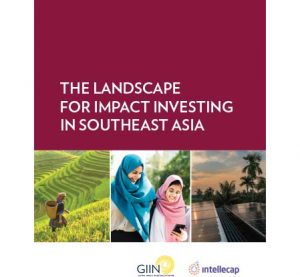The Landscape For Impact Investing In Southeast Asia

The Global Impact Investing Network (GIIN), in partnership with Intellecap Advisory Services, has published The Landscape for Impact Investing in Southeast Asia, the first-ever detailed analysis of impact investing activity across Southeast Asia. The report was generously supported by Investing in Women, an initiative of the Australian Government which is partnering with impact investors to grow impact investments in women owned and led SMEs in Southeast Asia. The Landscape for Impact Investing in Southeast Asia provides deep insight into the three most active markets in the region: Indonesia, Vietnam, and the Philippines, and a broader regional overview of the remaining eight countries, namely Brunei, Cambodia, East Timor, Laos, Malaysia, Myanmar, Singapore, and Thailand.
Abhilash Mudaliar, Director of Research at the GIIN, says, “The Asia Pacific region has been the fastest growing impact investing market worldwide over the past five years. This report shows why that’s not surprising. The countries across the region offer dynamic business environments with increasing entrepreneurial and investment activity focused on ensuring inclusive and sustainable economic development.”
The report outlines opportunities and challenges for impact investors and analyzes regulatory and economic factors that inform investment decisions in each country. Overall, the report sheds light on a dynamic and expanding regional impact investing market:
•Investment activity in Southeast Asia has increased over time. Since 2007, Private Impact Investors (PIIs) have deployed USD 904 million through 225 direct deals, and Development Finance Institutions (DFIs) have deployed USD 11.3 billion through 289 direct deals. For both sets of investors, investment activity has increased significantly in recent years.
•Indonesia, the Philippines, and Vietnam are the three largest markets in the region accounting for over 60% of capital deployed to date. However, each country in the region faces its own set of social and economic challenges, and presents investors with unique opportunities to develop strategies that both generate a financial return and have a positive impact.
•The top three impact investment sectors in the region have been financial services, energy, and manufacturing, accounting for over 80% of total capital deployed. As the market expands there is growing interest and activity in sectors such as education, healthcare, and workforce development.
On the findings, Mudaliar notes, “Historically, most capital for impact investing in the region has originated from investors in North America or Western Europe. A particularly promising trend is the growing participation of local investors – led by wealthy families and high net-worth individuals. We expect this trend to expand rapidly across all investor segments in the coming years.”
The report also finds that there is increasing awareness and uptake of gender lens investment (GLI) strategies in the region, which are investments that seek to address gender disparities and/or examine gender dynamics to inform better investment decisions. A growing number of investors have started developing GLI strategies in recent years, with USD 40 million deployed into more than 30 deals in Indonesia, the Philippines, and Vietnam alone.
Dr. Julia Newton-Howes, CEO of Investing in Women, argues, “This important research provides much needed market intelligence for Southeast Asia and reveals the growing appeal of impact investing in the region. Importantly, moving capital with a gender lens can unlock a significant under-served market and additional social impacts. Obviously, investing with a gender lens has a long way to go in the region, particularly with development finance. But we recognize that impact investing will not reach its full potential without incorporating an intentional gender lens and are proud to partner with the GIIN and Intellecap on this publication.”
The Landscape of Impact Investing in Southeast Asia report is based on interviews conducted with over 100 stakeholders, a thorough review of existing research, and aggregate analysis of over 500 impact investing transactions made since 2007.




